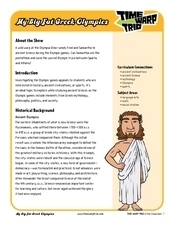Los Angeles Unified School District
Capitalism and Socialism
Capitalism, socialism, communism ... these may seem like a whole bunch of isms to your scholars. High schoolers won't confuse them after completing an informative resource. Your class masters how to use primary sources to...
Curated OER
Who's The Boss?
Upper elementary and middle schoolers research and analyze some different types of governments. Democracies, Monarchies, and Dictatorships are some of the types that are looked at. Learners use the Internet to gather information that...
Curated OER
Comparing Utah's Past and Present Government
Fourth graders research the past and present forms of government in Utah. In this government studies lesson students analyzes different forms of government and work with a group to gather information about how Utah was/is run and then...
Curated OER
The Three Branches of Government
Students complete a unit on the three branches of government. They compare/contrast the three branches of government, write a letter or e-mail to an executive in the Federal Government, and develop outlines for historical documents.
Curated OER
Critical Thinking About Government
Students research the Comox Band's system of government and report on what kind of government they think would work for them. In this government lesson plan, students decide between a hereditary system or an election system of...
Curated OER
Lesson Plan: U.S. Government
Students examine reasons for studying government. In this U.S. government lesson, students brainstorm the reasons for rules. Students draft their own class constitution in the style of the U.S. Constitution.
Curated OER
Wall Reading
Students are given practice in scan reading and in revising verb forms. They are given copies of Worksheet 2. Students are told that they should answer all the questions on the Worksheet and that it is a 'race.' They use thier short-term...
Curated OER
A FREE MARKET WITH THE HELP OF GOVERNMENT
Students engage in a study that explains how laws and government have policies that affect the economy to run more smoothly. The focus is upon the historical development of the free market and how the government was involved. Students...
Curated OER
Bill Of Rights
Students examine Supreme Court cases. In this U.S. government activity, students watch a video about the Bill of Rights and then research 4 Supreme Court cases using the noted web site. Students analyze the presented information and...
Curated OER
Group Newspaper-American System of Government
Eighth graders, in groups, design, research, and create a newspaper that explains four historical events that have influenced the American system of government.
California Polytechnic State University
Australian Geography Unit
At the heart of this resource is a beautifully detailed PowerPoint presentation (provided in PDF form) on the overall physical geography of Australia, basic facts about the country, Aboriginal history, and Australia culture and lifestyle.
Curated OER
We Are Colony! Settlement Design
Middle schoolers explore government systems. In this colonial America lesson plan, students consider colonial settlement needs as they design settlements that can sustain themselves and meet the needs of colonists.
Curated OER
Living in the Community
Students explore the differences between the four sectors of business. For this nonprofit business lesson, students give examples of needs met by businesses and the importance of the community nonprofit sector.
Curated OER
All the President's Men and Women
Students research responsibilities, programs and government departments of leaders that make up the presidential cabinet, in the form of a Web Exploration, after reading "Dueling Power Centers" from The New York Times.
Curated OER
The Bill of Rights
In groups, learners review one of four selected Supreme Court cases. The whole class watches a video introducing the four cases, and then small groups dive into Internet research in an attempt to write a two-paragraph summary of the...
Time Warp Trio
My Big Fat Greek Olympics
The Olympic Games are indeed a significant and far-reaching cultural component in our international community today, but from where do they originate? Where do our traditions stem from, and how do we choose the sports that constitute...
Constitutional Rights Foundation
The Election of 1912
The Election of 1912: an election with four competitive opponents. Pupils get to know the candidates with informative reading passages that provide context to the election. Then, the class engages in a debate and answers questions as one...
PBS
Universal Declaration of Human Rights
What rights are guaranteed to learners? Do they align with the Universal Declaration of Human Rights, which was approved by the United Nations in 1948? Middle and high schoolers present persuasive arguments about the rights they believe...
Curated OER
THE JUDICIAL BRANCH
Students create a series of drawings to show the process of how the Supreme Court does its work. The drawings may be in strip cartoon form or a series of separate illustrations.
Curated OER
A Walk Through the 20th Century
Students use primary and secondary sources to study the literature, historical events, people, technology, medicine, government, entertainment and culture of the decades of the twentieth century.
Curated OER
U.S. History: Virginia Assembly in America
Third graders discover the importance of the Virginia Assembly in English America as a governing body. After discussing the formation of the House of Burgesses, they elect their own representatives to make class decisions. In groups,...
Curated OER
Rome's Influence
Students identify ancient Roman influences in the modern world. In this ancient Rome lesson, student research the government, religion, economy, inventions and contributions of Rome.
Curated OER
Representation: Majority rule
Students explore various forms of decision making including majority rule, executive, consensus and autocracy (as well as exploring the power of veto), when they debate a bill in a class parliament.
Curated OER
Classifying Monocot And Dicot Plants
Sixth graders identify the parts of a flower, and tell the difference between monocots and dicots. They group plant by leaf types and characteristics placing the information in table form on the computer.























